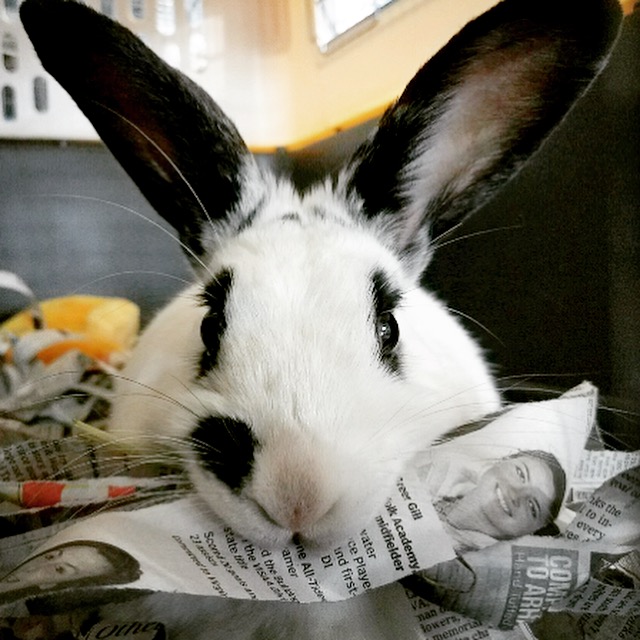
Rabbits love to chew. Unfortunately, rabbit chewing problems can lead to people surrendering their animals. Every no-kill shelter is always full, which means that rabbits go to shelters without no-kill policies, where they are typically euthanized within weeks.
Rabbit chewing, however, is often a problem that can be easily solved. We want to see pets stay in homes whenever possible. Here are tips to stop your rabbit from chewing your house:
1. Give Your Rabbits More Hay
Rabbits actually need to chew. Their teeth are always growing so if they stop chewing, they will have major medical problems. So, when a bunny chews, it is actually not doing anything wrong. Your bunny is just doing what comes natural.
The number one reason that we see with rabbits that have chewing “problems” (i.e. they are destroying your house by chewing) is that they are not getting enough hay. Your rabbit should be offered its weight in hay every single day. Yes, this is a lot of hay! Bunnies need a large quantity of hay to be healthy.
If your bunny isn’t chewing on the hay you give it, try a different variety. Here at the shelter, we use Timothy hay, but talk to your vet about other hay options. You can also try varieties from different companies. Some bunnies are just super picky.
You can also use the hay to create toys, which is more enriching than just having a pile of hay in your bunny’s potty box. In fact, let’s talk about that next…
2. Provide an Enriching Environment
Some bunnies chew because they are bored. It’s kind of like the way some humans have a snack when they are bored, even if they aren’t hungry. 🙂
The more enriching the environment, the less likely your bunny will have issues with chewing. They will be too distracted with all the fun things to do.
Don’t worry; creating an enriching environment does not have to be expensive. In fact, it can be free, using supplies that you probably already have around the house. Here at the shelter, we use heat-sealed boxes (anything without tape on it, so boxes from cereal, pasta, crackers, soda, etc. Stuff the box with hay and/or shredded newspaper, with enough room that your bunny can pull pieces out. If you want to really see your bunny go nuts, place a few treats in the hay as you stuff it. Your bunny will rip apart the box trying to find the reward.
You can also make toys with empty paper towel rolls. Just stuff with hay or newspaper. It’s the same idea.
Try filling your bunny’s area with other toys as well, such as old stuffed animals, soft cotton towels, and larger boxes with a hole in the side so they can run in and out. Just make sure that with any non-hay or non-paper item, your bunny is not ingesting the fibers as they play. If you are using old towels, carefully cut off any loose strings and toss them int he garbage as they rip to prevent any health problems.
3. Spay/Neuter
Sometimes bunny chewing is a hormonal problem. Bunnies should always, always, always be spayed or neutered when they are old enough (around 6 months – check with your vet). Most female bunnies will get ovarian cancer before the age of 5 if they are not spayed, and both spaying and neutering can have a DRASTIC positive effect on your bunny’s temperament.
If your bunny has been recently spayed or neutered, give it a little time. Most bunnies will grow out of it. Like puppies or kittens, younger bunnies have a lot of energy. They tend to mellow out as they mature.
4. Bunny-Proof Your House
Remember, a bunny is not doing anything wrong when it is chewy. It is just doing what comes naturally. As a responsible pet owner, it is important for you to bunny-proof your house, rather than blaming your furry friend for causing problems. After all, when you adopted your bunny, it didn’t have say in the matter. 🙂
Bunny-proofing can actually be quiet easy. It is similar to child-proofing, so items that keep toddlers safe also keep bunnies safe.
Be especially vigilant about cords. If a bunny chews on a cord, not only could it ingest pieces of rubber or wire, but it could also electrocute itself. Whenever possible, allow your bunny to roam freely in a room or area that does not have cords. You can use a baby gate or play pen to give your bunny freedom to roam without allowing access to cords. Some companies also create cages, barriers, and other solutions specifically to stop animals from reaching cords.
5. Use Positive Reinforcement and Training
Negative reinforcement might be your first instinct, but in reality, most bunnies just do not respond to it long-term. Clapping your hands or yelling “NO” might scare your bunny in the moment, so they stop chewing, but they typically do not associate the scary behavior with the activity of chewing. They are just learning to be scared of YOU.
Instead, try positive reinforcement. Give your bunny lots of rewards (like pets, cuddles, and occasional treats) when they are not chewing or when they are chewing on things they are allowed to chew.
You can also teach your bunny simple commands such as HOLD, which is training your bunny to stop what they are doing. Again, use positive reinforcement to train your bunny to listen to commands, and make sure you start training with a positive, patient mind set.
6. Spend Time Outside
Yes, your bunny can go outside if you have a secure area and the weather is not to hot. Spending time outside can be very enriching for a bunny, and they can chew and dig to their heart’s content, so when they come back inside, they will be more interested in eating and nappy than chewing.
Talk to your vet about safe temperature ranges for your specific bunny breed. For most breeds, anything above 80 degrees Fahrenheit is too hot, unless you have a lot of shade and it is significantly cooler in the shade. A temperature gun can help you estimate the temperature in both the sun and the shade. Bunnies are very prone to heat stroke, so be careful when the weather is warm.
When outside, provide lots of areas to hide so the bunny feels secure. This can be as simple as draping a sheet over a cage with the door open, so they can run in and out as they want. You can also cut a hole in the side of a large box.
Make sure that your fence is secure and that the bunny cannot dig under the fence. We recommend making sure the fence is buried at least 6 inches to a foot so that even if they do dig, they won’t get out.
If you don’t have a fenced in yard, you can also put your bunny in a pet play pen or gated area. Head to the park and enjoy some times in the sun with your bunny. ALWAYS supervise your bunny if they are in a pop-up play pen or gated area. Even in a secure yard, we recommend checking on your bunny at least once and hour, if not supervising the entire time.
7. Play, Play, Play!
As noted, you can stop bunnies from chewing if you make sure they are not bored. Fill their environment with enriching toys, and also make sure they get lots of playtime. You are their family. Spend time every day playing with your bunny. This can include a short 15-minute training session, and then lots of fun together. Bunnies might not play the same way dogs or cats play, but they still want to spend quality time with their humans.
You can also consider adopting a friend for your bunny. Most bunnies really enjoy the companionship of another bunny. We recommend pairing a male and female (both neutered/spayed) or two females. Two males can get along in some cases, but introductions might be more difficult, as some male bunnies tend to be more territorial when meeting another male bunny. It comes down to your bunny’s personality. The new playmate can distract your bunny from chewing.
No matter what, keep in mind that your bunny is relying on you. They need your love and support, even when they are frustrating you by chewing. Always be patient with your bunny, and remember your commitment to be a great pet owner.
If chewing persists despite doing your best to alleviate the problem, talk to your vet. It is rare, but sometimes chewing can be an indication of an underlying health problem. Check to make sure that your bunny is healthy by seeing a vet regularly.








